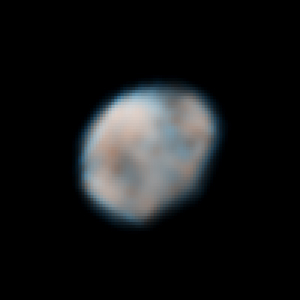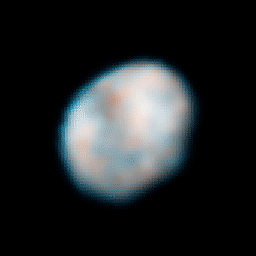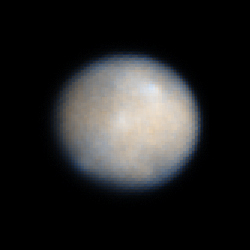Emily Lakdawalla • Jun 21, 2007
Tantalizing views of the worlds to be visited by Dawn
Yesterday the Space Telescope Science Institute released some new images of Vesta and Ceres, the two asteroids dwarf planets that are the targets for the soon-to-be-launched Dawn spacecraft. Ceres is the largest of the worlds of the Main Asteroid Belt, and Vesta battles with Pallas for the honor of being called second largest. So you might expect Vesta and Ceres to be rather similar, but from what we can see from Earth, they're very, very different. Here's the newly released image of Ceres (which was actually taken in 2004):

NASA, ESA, and Lucy McFadden (U. Maryland)
Vesta in color
This false color image of Vesta was taken by the Hubble Space Telescope Wide Field and Planetary Camera 2 on May 14, 2007. The image shows Vesta's lumpy shape, caused primarily by an impact crater on its south pole that has nearly the same diameter as the body itself. The variations in color show that Vesta likely has a compositionally diverse surface.Along with these two images they released a montage of 20 views of Vesta. Whenever I see a montage, my first instinct is to make an animation from it. I think this animation may show one full rotation of Vesta, though I wasn't able to get an answer to this question before writing this blog entry:

NASA, ESA, and Lucy McFadden (U. Maryland)
Rotating Vesta
This animation is composed of 20 images of Vesta captured on May 14 and 16, 2007 by the Wide Field Planetary Camera 2. Vesta has a mean diameter of approximately 530 kilometers (330 miles), but is slightly shorter pole-to-pole (464 km / 288 mi) than it is at the equator (570 km / 354 mi) and rotates in 5.34 hours. The colors are not true colors but do show color variations across the surface.These images from the Hubble Space Telescope represent the limit of what we can currently see of these two worlds from Earth. From such images, we've learned a lot about Ceres and Vesta -- for instance, the Ceres images have told us that Ceres is a differentiated world with a core, mantle, and crust, much like the icy satellites of Jupiter and Saturn. However, those blotches on the surface could be anything. Craters? probably there are craters, but what else might there be? Cryovolcanoes? Ridges and canyons? And Vesta -- that south polar impact certainly exposed the deep interior of a proto-planetary body. When we go visit Vesta, will we be able to see into the mantle or core of a terrestrial planetary body? Or has the ejecta from the impact, now deeply weathered, obscured the exposed interior? We just won't know until we go visit.
That's why I can't wait for Dawn to launch. I have to say that I am just as excited about our first visits to the dwarf planet or planets of the asteroid belt (due to Vesta not being round, I think it may not technically be a "dwarf planet" according to the IAU definition) as I am about New Horizons' first visits to the dwarf planets and smaller worlds of the Kuiper belt. Together these missions will complete the initial reconnaissance of all the main kinds of worlds in our solar system. Until somebody changes the definitions again, that is...
Dawn is still on schedule for a July 7 launch. Which is my 6th wedding anniversary. I hope Dawn launches, and for the mental health of the team I hope it launches sooner rather than later. But speaking ridiculously selfishly here, it would be much nicer for me and my husband if they delayed it by a day or two...
Support our core enterprises
Your support powers our mission to explore worlds, find life, and defend Earth. You make all the difference when you make a gift. Give today!
Donate

 Explore Worlds
Explore Worlds Find Life
Find Life Defend Earth
Defend Earth


